Aquarium Turtles as Pets
Choosing aquarium turtles as pets or other amphibians has become a popular choice. The question though is, is it a good option for you? Wow, this will be a tough one to answer. Why? Because I love small pet turtles. And I am a person that is hardly ever objective when loves something. But in this case - I will just have to be! Let us cover all aspects of pets in apartments and see how turtle ranks there.
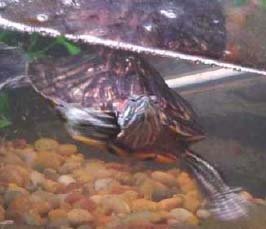
Aquarium Turtles as Pets is
Popular Option for Amphibian Lovers
Source: All Creatures Animal Hospital
Facts About Turtles
Common aquatic turtles as pets found in pet stores include:
- Painted Turtles (common in pet stores)
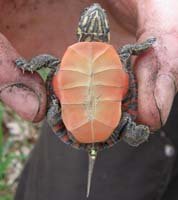
Baby Painted Turtle is a Common Choice when selecting Turtles as Pets
Source: United States Fish and Wildlife Service
- Red Ear Turtles (common in pet stores)
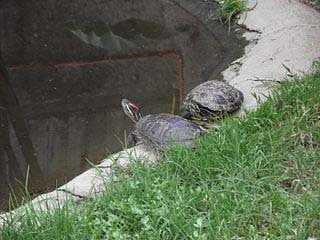
Red Ear Turtles at the Tortugas de Orejas Rojas Zoo
- Map Turtles
- Asian Leaf Turtles
How to Tell the Sex of a Turtle
In general, to tell the sex of a turtle start by examining the tail. The male turtle tail is bigger than the female. The male phallus and female genitals are contained in an area of the tail called the cloaca. In females, this is located just before the end of the upper shell. In males, it is just past the end of the upper shell.Turtle's lifespan
When you commit to turtles as pets it is a long term relationship. If you take good care of your pet it will live for decades. Basically, you can have it for life. The rule is that the bigger the specie is, the longer it will live. They will live approximately 20 to 40 years.
Size of the turtle
I am mainly discussing apartment pets so I will do the same here. For small apartments the best, and the only proper turtle as pet is an aquatic turtle. So the size of the pet will not play a big role. Although you will need to consider getting a fairly large turtle tank. Aquatic turtles will grow from 5 to 11 inches long.
Cost of the pet
There are two common turtles as pets found in pet shops. They are Eastern painted turtle and Red ear slider turtle. The price is around $15 - $20 US dollars.
Wild or bred in captivity
Definitely not a wild one. First of all it is not
a good idea to remove wild animals from their habitats. Then it might
be illegal. The animal can also be sick and you don't
want your kids to play with a sick wild animal. Turtles bred in
captivity are not expensive and they are a much better choice.
Turtle Hibernation
In the wild, turtles hibernate during the winter. This
instinct is retained by some aquarium turtles, however, in general it
is not encouraged since turtles have to be in excellent shape to
survive. For this reason, hibernation is a controversial subject among
veterinarians and animal professionals. If you do encourage your pet
turtle to hibernate, first have him or her checked by a veterinarian.
Afterward, with-hold food for 2 weeks and bring the temperature of the
habitat down to 45°-55°. The temperature can be reached at once or
gradually. Never bring the temperature to freezing levels.
What You'll Need When Caring for Turtles
There are quite a few items you'll need to properly care for your turtle. This includes:- Habitat or Tanks for Turtles
- Turtle Food
- Turtle Vitamin Supplement
- Turtle Calcium Supplement
- Cricket Keeper
- Cricket Food
- Turtle Treats
- Heat Light and Fixture
- Under Tank Heater
- Tank Water Filter
- UVB Lighting
- Substrate (slate, rock or gravel)
Habitat and Tanks for Turtles
Forget about small plastic containers with a palm tree in the middle, that is completely inappropriate habitat for turtles as pets.
This is what makes turtles as pets pretty expensive. You will probably need several hundreds of US dollars to set up a turtle tank. You will need a tank, basking area, UV light, water heater, water pump and an aquatic turtle tank filter.You can make a dry basking area yourself or buy one. Here are some basking platforms with price range starting from around 8 US dollars. Depending on the tank and turtle size, you can buy ones that are anywhere from $8 to $20 US dollars. Basking platform is one of the things you can save money on. You could even make the tank yourself.
If you want some decoration, you might spend more money but it is not a must because you can decorate the tank yourself with some small rocks. Remember that the health of your turtle is directly related to the health of his or her environment. In terms of size a rule of thumb is 10 gallons per turtle inch. In general a 40 gallon turtle breeder tank is needed with a screened top.
Turtle Habitat
Pet aquatic turtles swim and drink the same water. Because of this
the water needs to be frequently changed. In terms of materials in the
tank, large smooth gravel, rock or slate is required. Some turtles need
an a location in the tank where they can be in the water with the head
sticking out. The red ear turtle breed needs a place to rest with no
water. Most turtles need an area where they can bask outside of the
water. Being out of the water helps to dry the skin and shell, reducing
bacteria levels. It also helps with UVB light absorption.
Turtle Tank Temperature
Turtles as pets should be kept at 95° for areas out of the water
and 75° for areas where there is water. Heat is produced by either a
ceramic heater or incandescent light.
Turtle Tank Lighting
A turtle tank should be lit with UVB rays for 10 to 12 hours a day
in the basking area. Light helps the body absorb heat and work
optimally. The UVB helps the turtle naturally synthesize vitamin D and
absorb calcium. The turtle light should be placed 1 foot from where the
turtle will bask.
Turtle Care and Upkeep
Upkeep of turtles as pets will not be too expensive. As you can see, the set up is a bigger problem. Turtle food price is acceptable. You can add some meat, fruit and vegetables from your own food (before you prepare it). Turtle pellets are reasonable priced. You will need some turtle vitamins (which are actually very cheap) and that is it. The upkeep should be less than 50 US $ a month (maybe even less then this, depending on the country).
Now, the vet might cost some. But if you got a healthy pet at the beginning, you provide a good turtle diet and clean the tank regularly (at least 1x per week), maybe you will not need a vet. The key to turtle care is maintaining clean water. When replacing the water, clean dechlorinated water will be needed at 75° degrees. If the water is chlorinated it should bother the turtle since turtles do not breath in the water. New water can be completely or partially replaced in larger tanks at the same temperature. Turtles do not like temperature change. To prevent turtle shell rot the ideal PH is 6.7 to 6.9. Any feces and uneaten food should be removed as soon as possible. Turtles do not like to be frequently handled and may bite. Never combine turtle species in the same tank.
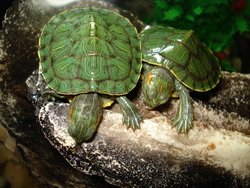 Both photos courtesy of Dimitris Siskopoulos |
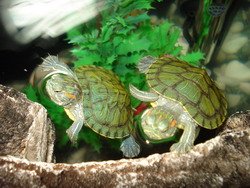 |
Commitment and Interaction
How much will you need to commit to turtles as pets? As far as it
comes to socializing the pet, there is nothing to worry about. They
don't need it. They don't even need you to play with them. So this pet
is good for people that don't want to spend time interacting with their
pet. You can also read this brochure from the AVMA on choosing
an Amphibian (PDF Download).
TIP
Make sure that buying or keeping turtle as pets is legal in your country.
Making mess
Turtles as pets don't make a mess outside the tank but they make a big mess on the inside. So, as already said, either you buy them water filters or be prepared for some cleaning. You can make the tank water "last longer" if you feed your turtles in a separate bowl.
Is the silence worth it?
People usually think that turtles are easy to keep pets because they are so quiet and they just swim around all day. Don't be tricked by this. You will need a lot of maintenance time to keep a small pet turtle happy.
Turtle Food and Diet
The diet is made of various turtle foods but it will be very easy to provide everything the pet needs, just check out our turtle diet page. When young a turtle is a carnivore (will eat insects such as crickets) and when older will eat plants (omnivore). Map and Asian leaf turtle live on live comet goldfish, earthworms, meal worms, bloodworms, crickets and snails. Rad Ears also benefit from the aforementioned foods. Painted wood and red ear turtles eat dark leafy green vegetables, and chopped vegetables. All breeds eat turtle pellets.
Most of the common pet turtles (red-eared sliders, painted turtles)
will do well on a combination of commercial turtle pellets, fish
pellets, gut loaded insects, earthworms, small fish (goldfish, guppies,
and minnows), greens, and water plants. Check with your veterinarian or
pet store for the best turtle diet for your pet.
Young turtles are fed everyday while adults eat every other day. Turtle food should be sprinkled with a vitamin and calcium supplement.
Tip:
Feed your turtles in a smaller tub of water out of the main tank. This
will improve the water quality in the main tank. Water in the tub
can be changed after every feeding.
Turtles as Pets for Kids
Turtles as pets for kids is not a good idea if the children are
going to be always supervised when handling the pets. If you plan
to take care of
them, clean them and only let your kid look at it or play a bit than it
is OK. A child can not take proper care of a small pet turtle. Children
should be supervised and taught proper hygiene.
Important note when it comes to turtles for kids: turtles can be a source of salmonella so make sure your kids wash hands every time they play with the turtle. Surfaces also can spread salmonella if a turtle is allowed to crawl on counter tops or carpet. The CDC describes examples of turtles and salmonella including people who became sick after touching, feeding, changing turtle water or cleaning the habitat. Two teenagers became sick after swimming in an dechlorinated in-ground poll after their tootles also took a swim.For more on tootles and salmonella download this brochure from the U.S. Department of Health and Human Services.
References:
All Creatures Animal Hospital
Related Articles
How
to buy a pet turtle
Turtle food
Types
of pet turtles
Turtle tanks
Go from turtles as
pets to Cool Small Pets home page
Comments
Have your say about what you just read! Leave me a comment in the box below.